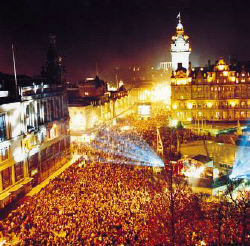Let’s face it – Scotland isn’t exactly known for its cuisine, at least historically speaking. While there are some chefs these days that are doing more than just the usual meat and potatoes fare, Edinburgh probably isn’t the place to go for a food-centric holiday.
Unless, of course, you’re in the mood for some haggis.
Haggis is one of those legendary foods that often trotted out in conversations with the culinarily squeamish, but there’s very little reason it should be any more unappetizing than any other sausage. Of course, what’s the old joke about sausage? You don’t want to know how it’s made. Well, if you’re among that lot, you’ll want to look away, because you’re about to learn how haggis is made.
In most recipes, the innards of the haggis consist of the heart, liver and lungs of a sheep, minced together with onion, oatmeal, suet and spices. The entire mixture is then stuffed inside a sheep’s stomach (or a more modern sausage casing) and then boiled for about an hour. The end result is a large brownish sausage-looking thing, which is sliced into and shared. And though it might not sound very appetizing, unless you’re strictly an herbivore – give it a try. You only live once, right?
 Edinburgh in winter might sound like it would be dreary, but it’s decidedly not. And one of the main reasons is that one of the city’s best festivals takes place at New Year’s – it’s Hogmanay in Edinburgh.
Edinburgh in winter might sound like it would be dreary, but it’s decidedly not. And one of the main reasons is that one of the city’s best festivals takes place at New Year’s – it’s Hogmanay in Edinburgh. Leave it to a pub to glorify an 18th century burglar in such a way as to turn the pub into a tourist attraction and the burglar into a celebrity.
Leave it to a pub to glorify an 18th century burglar in such a way as to turn the pub into a tourist attraction and the burglar into a celebrity. Travel has a way of bringing out the kid in everyone – diet and curfew be damned! You get to let loose your inner child and do just as you please for the duration of your holiday. Which is why a visit to the Edinburgh Museum of Childhood is so perfectly appropriate.
Travel has a way of bringing out the kid in everyone – diet and curfew be damned! You get to let loose your inner child and do just as you please for the duration of your holiday. Which is why a visit to the Edinburgh Museum of Childhood is so perfectly appropriate.